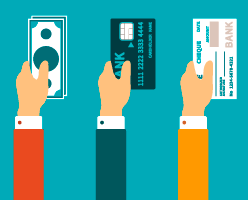 The number of payments made by check is declining, butlockboxes, the bank facilities that process payments forbusinesses, are keeping busy. The demand for their services iscoming partly from companies that used to process their ownpayments but decided they could benefit from using a lockboxinstead. Lockboxes are also increasingly processing electronicpayments in addition to paper checks.
The number of payments made by check is declining, butlockboxes, the bank facilities that process payments forbusinesses, are keeping busy. The demand for their services iscoming partly from companies that used to process their ownpayments but decided they could benefit from using a lockboxinstead. Lockboxes are also increasingly processing electronicpayments in addition to paper checks.
An Aite Group report released last year estimated that retaillockbox, which handles consumer payments to businesses, is growing0.4% a year as more consumers pay bills online, while wholesalelockbox, which deals with business-to-business payments, is growingat a compound annual rate of 2.9%.
|Nancy Atkinson, a senior analyst at Aite Group, said that whilethe use of checks is not growing, lockbox volume is getting a boostas companies that previously handled their receivables in-housedecide to outsource that work, perhaps because they're impressed bythe efficiencies offered by increasingly automated lockboxes.
|Companies are “looking for the opportunities out of that,”Atkinson said. “As new equipment comes along, I think a good numberof large corporates are going to look to either their bank or athird-party processor.”
|Using a lockbox is particularly attractive for companies if thelockbox can handle not only paper, but all types of payments, shesaid. “If they can find a way to get it all consolidated, it willmake it easier for them.”
|Ray Gatland, senior vice president and lockbox services groupproduct manager at Wells Fargo, said compliance issues related toregulations like the PCI security standards for card payments arealso pushing companies toward having a bank or third-party lockboxprocess their payments. “All of the various regulatory andcompliance regimes are very much changing what someone who doestheir own processing in-house can do or might want to do,” hesaid.
|Another factor is the prospect that mail delivery will slow asthe U.S. Postal Service cuts back in the face of fallingrevenue.
|“I absolutely tell my clients: The day is coming when mail floatwill be degraded; there's going to have to be some hard choices,”said Rodney Gardner, head of global receivables in GlobalTransaction Services at Bank of America Merrill Lynch. “That, tome, is another reason to think about moving from paper toelectronic.”
|Going forward, Gardner said, he would like to locate lockboxfacilities in the fastest cities (as measured by Phoenix-Hecht)needed by the bank's clients and “in very close proximity”to the Postal Service's mail-sorting facilities.
|Checks' Staying Power
| While the useof paper checks may be declining, “checks aren't going anywhereanytime soon in the B2B space,” said Gardner, pictured at left. AFed study showed that while consumer-to-business checks had fallenalmost 10% between 2009 and 2013, business-to-business checks wereoff only 3.8%, he said.
While the useof paper checks may be declining, “checks aren't going anywhereanytime soon in the B2B space,” said Gardner, pictured at left. AFed study showed that while consumer-to-business checks had fallenalmost 10% between 2009 and 2013, business-to-business checks wereoff only 3.8%, he said.
More and more businesses are taking advantage of the savingsthat can be realized by paying electronically—for instance, via ACHinstead of by check. But for the company that's owed the money,electronic payments complicate the reconciliation of payments to invoices.
|“The remittance data on an electronic transaction presents awhole new host of challenges vis-a-vis the way you take in papertoday,” Gardner said.
|Information about an ACH payment might arrive by email, separatefrom the payment, he said, and the information that accompanies anelectronic payment will vary from client to client. “How does yourbank or third-party processor know where to find the invoicenumber?” he said. “It's almost like you're reinventing lockbox.
|“You have to invest in new technology, as a bank or non-bankprovider, if you want to drive paper-to-electronic migration,”Gardner added.
|Technology Advances
|Lockbox technology has already made great strides. For the mostpart, facilities have left manual processes and inputting behind.Machines open envelopes, scan checks and documents, and use opticalcharacter recognition technology to gather from those documentsinformation about how much is being paid and which invoices areinvolved.
| “There's been a dynamic shift, alot of that wrapped around image technology, recognitiontechnology, and how we service customers around the variouspayments,” said Gatland, pictured at right. “As those players thatcontinue to be in the lockbox processing space understand the valueproposition for our clients, they will continue to invest in thosetechnologies that help them do it better.”
“There's been a dynamic shift, alot of that wrapped around image technology, recognitiontechnology, and how we service customers around the variouspayments,” said Gatland, pictured at right. “As those players thatcontinue to be in the lockbox processing space understand the valueproposition for our clients, they will continue to invest in thosetechnologies that help them do it better.”
Gardner said that when it comes to dealing with electronicremittance data, lockboxes need technology that learns.
|He cited the example of a customer that always cuts off thefirst two digits of an invoice number when making electronicpayments. “What is required is software that can remember thatpattern,” he said. “When you do the exact same thing next month andeverything else matches, the system will auto-post those first twodigits.”
|Technology can also now handle the situation of a payment that'saccompanied by an email with the remittance information, Gardnersaid, noting that gathering information from an email isn't muchdifferent from gathering the data from a scanned paper remittancedocument. And when the customer sends an electronic payment alongwith a link to a Web page that provides information about thepayment, lockbox technology can incorporate “website crawlers,” hesaid, software that can pull the page and get the information.
|Gatland cited a tighter integration of remote deposit capture(RDC) technology with lockboxes.
|“If you think about RDC as a way of organizations being able tocapture checks and deposit those into accounts themselves, this isthe next step,” he said. Wells Fargo's new Virtual Lockbox productlets companies scan not only the check, but also any accompanyingcorrespondence, and then feed those images into the lockbox. “Wetake those payments, which would have been stranded otherwise, andintegrate them into their receivables flow,” Gatland said.
|In B2B receivables, the name of the game is to be able to matchas many payments as possible to the appropriate invoices, despitethe vagaries of remittance information.
|The key is to focus on ensuring straight-through reconciliation, Gardner said. “I think areasonable target for a corporate is to say, 'I'm going to try toget 90% of my transactions to post.'”
|Atkinson said some lockbox providers are trying to resolveproblems by providing workflow that allows buyers and sellers tocome to terms when problems arise. “That's something a lot of theproviders are looking to add, if they don't have it already, alongwith being able to provide consolidated receivables or integratedreceivables, and provide information across multiple paymentchannels and multiple payment instruments,” she said.
|Gatland said technology can allow a company's employees to weighin on payments the lockbox is having a hard time applying.
|“We have built an online decisioning capability so if there isan inbound payment that needs to be matched to a receivables recordor a payment that, because of information not provided by theremitter, doesn't allow us to provide a clean input without anexception, we can make that information available to our client sothey can go in and review it,” he said. “They can correctinformation; they can match information to their receivable. So atthe end of the day, when it's time for us to create the postingfile, it's much, much cleaner.”
Complete your profile to continue reading and get FREE access to Treasury & Risk, part of your ALM digital membership.
Your access to unlimited Treasury & Risk content isn’t changing.
Once you are an ALM digital member, you’ll receive:
- Critical Treasury & Risk information including in-depth analysis of treasury and finance best practices, case studies with corporate innovators, informative newsletters, educational webcasts and videos, and resources from industry leaders.
- Exclusive discounts on ALM and Treasury & Risk events.
- Access to other award-winning ALM websites including PropertyCasualty360.com and Law.com.
*May exclude premium content
Already have an account? Sign In
© 2024 ALM Global, LLC, All Rights Reserved. Request academic re-use from www.copyright.com. All other uses, submit a request to [email protected]. For more information visit Asset & Logo Licensing.







